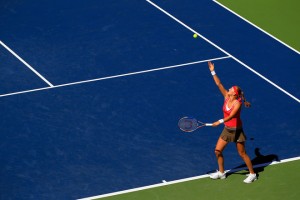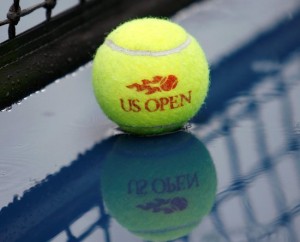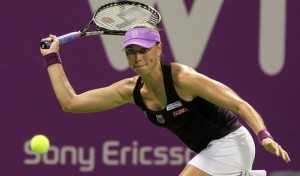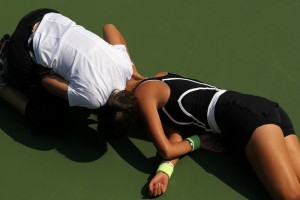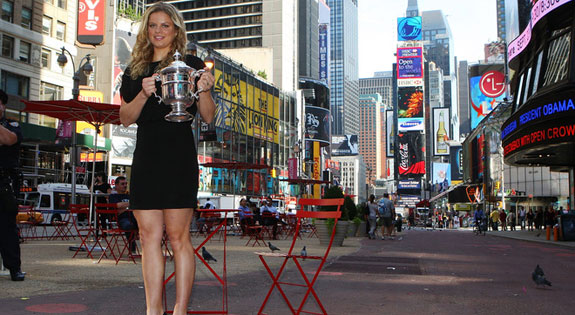By Thomas Swick
swickt@bellsouth.net
The Billie Jean King National Tennis Center sits on land once occupied by state pavilions during the 1964-65 New York World’s Fair. Until I arrived yesterday, I had always thought it was in the old transportation section, replacing General Motors’ city of the future and Ford’s dinosaurs (an exhibit that, in the ‘60s, ran no risk of seeming ironic – or prophetic). Last night, riding the escalator at Arthur Ashe Stadium, I was thrilled to see what looked like the old heliport, where, as a boy, I imagined the city’s elite – Roger Maris, Dorothy Kilgallen, Tony Bennett – dining under modernistic chandeliers. The Unisphere still stands (a popular subject for TV cameras), as do the two disk-topped towers of the old New York State pavilion. The Illinois pavilion was somewhere around here, with its talking Abraham Lincoln, one of the world’s first glimpses of Disney’s audioanimatrons. For a seventh-grader, this was magical, hallowed ground.
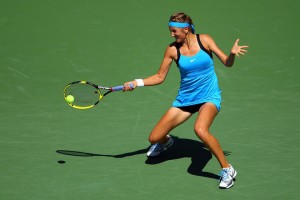
It still is. Yesterday evening a crowd gathered near the media center (the door sometimes doubling as the players’ entrance) and, after a few minutes, a boy came running over to his father. “I got Federer’s autograph!” he cried, proudly showing the scribble on his souvenir fan. It didn’t matter that it looked more like initials than a signature. Then, with the dreamy look of a budding Wall Street trader – and the same self-delusion – the boy announced: “I’ll sell this for a million bucks.”
This morning, near the very same spot, Paul Hunsader, a retired tomato farmer from Bradenton, Florida, complained about the section that had been built at the far end of the practice courts – just for media. He had been coming to the U.S. Open every year since ’85, and it wasn’t, he said, “fan friendly anymore.”
I asked if he had any other complaints.
“Sharapova’s got to stop her squealing.”
Paul always attended the first week. “We want to see the new players.” A distant cry from the practice courts broke his concentration.
“That’s Sharapova,” he said. “I know that squeal.”
I wished him a good week and wandered over to the practice courts. Victoria Azarenka was on Court 4, erupting after every methodical forehand. A tennis audioanimatron.
A tall tanned man was practicing on one of the play courts.
“Who’s that?” I asked a female spectator.
“I don’t know,” she said.
Her name was Tiffany and, I soon learned, she had trained at the Bollettieri Academy during the glory years. (Bradenton again.) “I was there when Monica Seles, Andre Agassi, Jim Courier were there,” she said. “It was hard to get noticed. Which was good.” She was still involved in tennis, and here liked to wander the outside courts. “I also like to play the games,” she said, explaining that there are lots of games, not just tennis, set up for fans. “I don’t like to sit still.”
I made my way to the Court of Champions and read the tablets. Ken Rosewall (“one of the game’s greatest champions and grandest gentlemen”), John McEnroe (“his swooping left-handed serve deceptively oppressive”), Chris Evert (“unflappable, usually unstoppable”), Bill Tilden (“a majestic Philadelphian”), Jimmy Connors (“two-handed backhand and two-fisted attitude”).
“These are quite well written,” I said to the man who was one tablet behind me. He seemed to be reading not really with awe, but rather a sense of verification, to make sure the writer had got it right. His name was Jerry Rush, and he had been a coach: Vincent Van Patten, Vitas Gerulaitis, Tony Bennett.
“I flew in with Tony Bennett,” he said. “We came straight from the airport. I’ve given him lessons over the years. He’s in great shape. He’s 85.”
Jerry was 81. He took out his wallet and searched through a pile of cards, eventually pulling out a small photograph taken of a portrait of himself in white tennis cap, the lines of a tennis court in the background.
“Tony painted this for me,” he said, “for my 80th birthday.”

